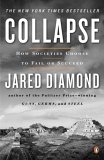Summary | Excerpt | Reading Guide | Reviews | Beyond the Book | Readalikes | Genres & Themes | Author Bio

Critics' Opinion:
Readers' Opinion:
First Published:
Dec 2004, 575 pages
Paperback:
Jan 2006, 592 pages
 Book Reviewed by:
Book Reviewed by:
BookBrowse Review Team
Buy This Book
Chapter 13: "Mining" Australia
Australia's significance
Soils
Water
Distance
Early history
Imported values
Trade and immigration
Land degradation
Other environmental problems
Signs of hope and change
Part Four: PRACTICAL LESSONS
Chapter 14: Why Do Some Societies Make Disastrous
Decisions?
Road map for success
Failure to anticipate
Failure to perceive
Rational bad behavior
Disastrous values
Other irrational failures
Unsuccessful solutions
Signs of hope
Chapter 15: Big Businesses and the Environment:
Different Conditions, Different Outcomes
Resource extraction
Two oil fields
Oil company motives
Hardrock mining operations
Mining company motives
Differences among mining companies
The logging industry
Forest Stewardship Council
The seafood industry
Businesses and the public
Chapter 16: The World as a Polder: What Does It All Mean to Us Today?
Introduction
The most serious problems
If we don't solve them . . .
Life in Los Angeles
One-liner objections
The past and the present
Reasons for hope
Acknowledgments
Further Readings
Index
Illustration Credits
LIST OF MAPS
The World: Prehistoric, Historic, and Modern Societies
Contemporary Montana
The Pacific Ocean, the Pitcairn Islands, and Easter Island
The Pitcairn Islands
Anasazi Sites
Maya Sites
The Viking Expansion
Contemporary Hispaniola
Contemporary China
Contemporary Australia
Political Trouble Spots of the Modern World;
Environmental Trouble Spots of the Modern World
Prologue: A Tale of Two Farms
Two farms. Collapses, past and present.
Vanished Edens?
A five-point framework.
Businesses and the environment.
The comparative method.
Plan of the book
A few summers ago I visited two dairy farms, Huls Farm and Gardar Farm, which
despite being located thousands of miles apart were still remarkably similar in
their strengths and vulnerabilities. Both were by far the largest, most
prosperous, most technologically advanced farms in their respective districts.
In particular, each was centered around a magnificent state-of-the-art barn for
sheltering and milking cows. Those structures, both neatly divided into
opposite-facing rows of cow stalls, dwarfed all other barns in the district.
Both farms let their cows graze outdoors in lush pastures during the summer,
produced their own hay to harvest in the late summer for feeding the cows
through the winter, and increased their production of summer fodder and winter
hay by irrigating their fields. The two farms were similar in area (a few square
miles) and in barn size, Huls barn holding somewhat more cows than Gardar barn
(200 vs. 165 cows, respectively). The owners of both farms were viewed as
leaders of their respective societies. Both owners were deeply religious. Both
farms were located in gorgeous natural settings that attract tourists from afar,
with backdrops of high snow-capped mountains drained by streams teaming with
fish, and sloping down to a famous river.
Those were the shared strengths of the two farms. As for their shared
vulnerabilities, both lay in districts economically marginal for dairying,
because their high northern latitudes meant a short summer growing season in
which to produce pasture grass and hay. Because the climate was thus suboptimal even in good years, compared to dairy farms at lower latitudes, both farms were
susceptible to being harmed by climate change, with drought or cold being the
main concerns in the districts of Huls Farm or Gardar Farm respectively. Both
districts lay far from population centers to which they could market their
products, so that transportation costs and hazards placed them at a competitive
disadvantage compared to more centrally located districts. The economies of both
farms were hostage to forces beyond their owners' control, such as the
changing affluence and tastes of their customers and neighbors. On a larger
scale, the economies of the countries in which both farms lay rose and fell with
the waxing and waning of threats from distant enemy societies.
From Collapse by Jared Diamond. Copyright Jared Diamond 2005. All rights reserved. No part of this book maybe reproduced without written permission from the publisher.





The House on Biscayne Bay
by Chanel Cleeton
As death stalks a gothic mansion in Miami, the lives of two women intertwine as the past and present collide.

The Flower Sisters
by Michelle Collins Anderson
From the new Fannie Flagg of the Ozarks, a richly-woven story of family, forgiveness, and reinvention.

The Funeral Cryer by Wenyan Lu
Debut novelist Wenyan Lu brings us this witty yet profound story about one woman's midlife reawakening in contemporary rural China.
Your guide toexceptional books
BookBrowse seeks out and recommends the best in contemporary fiction and nonfiction—books that not only engage and entertain but also deepen our understanding of ourselves and the world around us.